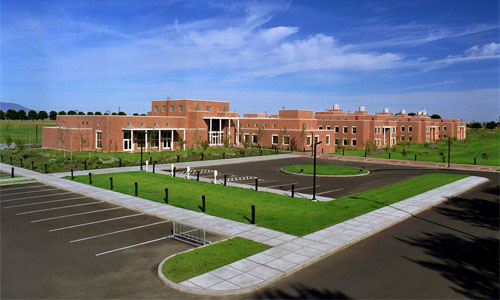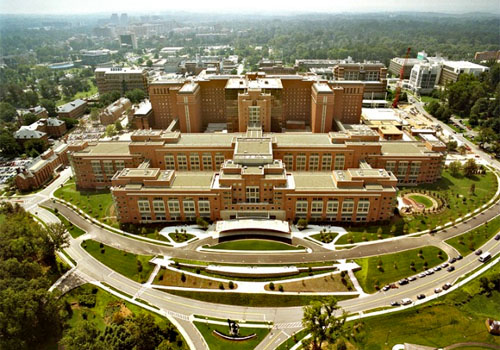Overview
Within This Page
As symbols of the Nation's technological progress, research facilities are essential to the discoveries and breakthroughs of yesterday, today, and tomorrow. Thousands of public and private sector scientists and engineers from industries such as pharmaceutical, biomedical, manufacturing, and biotechnology use all types of laboratories and instruments to advance the frontiers of knowledge. At times, an entire facility may be built to support the specialized instruments required for research, including accelerators, light sources, research reactors, neutron beam facilities, plasma, fusion science facilities, genome centers, advanced computational centers, wind tunnels, model testing facilities, hot cells, and launch facilities.
There are many kinds of research facilities. Within the WBDG they are divided into two major groups: Animal Research Facilities and Research Laboratories. Research Laboratories are further categorized by type (e.g., wet labs and dry labs), and by sectors (e.g., academic, corporate, and government labs).
Many existing research facilities, especially those in government agencies and universities, are at an age when renovations are needed to support the state-of-the-art research required to be at the cutting edge of science and technology. While this section of the WBDG provides information on the design and construction of new research facilities, the principles covered can be applied to renovation projects as well.

Environmental Molecular Sciences Laboratory (EMSL), at DOE's Pacific Northwest National Laboratory has unique and state-of-the-art research resources. Richland, WA.
Building Attributes
Example Design and Construction Criteria
For GSA, the unit costs for this building type are based on the construction quality and design features in the following table . This information is based on GSA's benchmark interpretation and could be different for other owners.
Classification
Research facilities present a unique challenge to designers with their inherent complexity of systems, health and safety requirements, long-term flexibility and adaptability needs, energy use intensity, and environmental impacts. There are many different types of research facilities. Within the WBDG they are divided into two major groups, which are then further categorized by type and by sector:
-
Animal Research Facilities, also known as vivariums, are specially designed building types that accommodate exquisitely controlled environments for the care and maintenance of experimental animals.
-
Research Laboratories are complex, technically sophisticated, and mechanically intensive structures that are expensive to build and to maintain. Therefore, the design, construction, and renovation of such facilities are a major challenge for all involved.
- Type: Wet; Dry
- Sector: Academic; Government; Private Sector

The National Institutes of Health Clinical Center in Bethesda, Maryland, provides a crucial link in rapidly moving research findings from the laboratory to mainstream medical practice.
A new model of laboratory design is emerging, one that creates lab environments that are responsive to present needs and capable of accommodating future demands. Several key needs are driving the development of a new model. See WBDG Trends in Lab Design for a complete overview.
Additional Resources
Federal Agencies
- Department of Energy (DOE), Office of Environment, Health, Safety & Security
- For examples of facilities to support instruments of science, see DOE's Brookhaven National Laboratory
- Department of Veterans Affairs, Office of Construction & Facilities Management
- Environmental Protection Agency, Office of Administration and Resources Management
- General Services Administration, Office of Design and Construction: Office of the Chief Architect
- National Aeronautics and Space Administration, Facilities and Real Estate Division
- National Institutes of Health, Office of Research Facilities, Development and Operations developed the NIH Design Requirements Manual to provide standards to assist planners, architects, and engineers in designing biomedical and animal research facilities for the NIH.
Organizations/Associations
- Laboratories for the 21st Century (Labs21)—Sponsored by the U.S. Environmental Protection Agency and the U.S. Department of Energy, Labs21 is a voluntary program dedicated to improving the environmental performance of U.S. laboratories.
- A Design Guide for Energy-Efficient Research Laboratories—A reference that helps facility owners, managers, and designers apply energy-efficiency features in laboratories.
- Environmental Performance Criteria (EPC)—The Labs21 Environmental Performance Criteria is a rating system specifically designed for laboratory facilities. It builds on the U.S. Green Building Council's LEED® Green Building Rating System.
- Labs21 Design Process Manual—Includes a "quick reference" sustainable strategies checklist as well as links to key resources for each stage of the design process.
- Labs21 Tool Kit
- Labs21 Annual Conference Presentations Archive
- U.S. Green Building Council's LEED®—Because research facilities present a unique challenge for energy efficiency and sustainable design, the USGBC formed the LEED-AGL Committee to develop a guide that helps project teams apply LEED credits in the design and construction of laboratory facilities.
Publications
- ASHRAE 110 Method of Testing Performance of Laboratory Fume Hoods
- ASHRAE Handbook
- ASHRAE Laboratory Design Guide
- Biosafety in Microbiological and Biomedical Laboratories (BMBL) 5th Edition by U.S. Department of Health and Human Services, Centers for Disease Control and Prevention and National Institutes of Health. Washington, DC: U.S. Government Printing Office, December 2009.
- Building Type Basics for Research Laboratories, 2nd Edition by Daniel Watch. New York: John Wiley & Sons, Inc., 2008. ISBN# 978-0-470-16333-7.
- Guidelines for Planning and Design of Biomedical Research Laboratory Facilities by The American Institute of Architects, Center for Advanced Technology Facilities Design. Washington, D.C.: The American Institute of Architects, 1999.
- R&D Magazine—Provides information on a variety of topics related to laboratories. The R&D Lab of the Year award is presented annually to outstanding laboratory facilities throughout the United States.
Others
- Building Research Information Knowledgebase (BRIK)—an interactive portal offering online access to peer-reviewed research projects and case studies in all facets of building, from predesign, design, and construction through occupancy and reuse.
- GSA Sustainable Facilities Tool (SFTool)—SFTool's immersive virtual environment addresses all your sustainability planning, designing and procurement needs.








